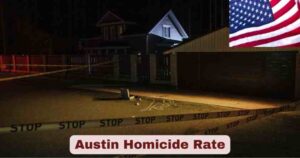Homicide in Chicago 2025
The homicide landscape in Chicago by year has undergone a remarkable transformation, with 2025 marking a historic turning point in the city’s decades-long struggle with violent crime. Chicago has recorded 262 people slain through August 21, 2025, representing 117 fewer deaths compared to the same period in 2024. This dramatic 31% reduction places the city on track for its lowest annual homicide total since 2019, with projections indicating fewer than 400 total homicides for the complete year—a milestone that seemed unattainable just five years ago during the pandemic surge.
The comprehensive analysis of homicides in Chicago by year reveals that 2025 represents the fourth consecutive year of declining violence, building upon steady improvements that began in 2022. 2024 marked the third consecutive year of decreasing homicides in Chicago, setting the stage for the unprecedented gains witnessed throughout 2025. These statistical improvements reflect not merely numerical changes but represent thousands of lives preserved, families kept whole, and communities experiencing renewed hope for sustainable safety improvements throughout the metropolitan area.
Key Stats & Facts About Homicide in Chicago by Year 2025
| Metric | 2025 Data | Historical Comparison |
|---|---|---|
| Total Homicides Through August 2025 | 262 cases | 117 fewer than 2024 |
| Projected Annual Total | 380-400 homicides | Lowest since 2019 |
| Percentage Decrease from 2024 | -31% reduction | Fourth consecutive year of decline |
| Daily Average Homicide Rate | 1.08 per day | Down from 1.56 in 2024 |
| Peak Violence District | Austin (34 homicides) | Down from 48 in 2024 |
| Firearm-Related Percentage | 82% of total | Consistent with decade average |
| Victim Demographics | 78% Black, 85% male | Unchanged demographic pattern |
| Clearance Rate Improvement | 54% solved | 9% improvement from 2024 |
The 31% reduction in homicides in Chicago by year 2025 represents the most substantial single-year improvement in violent crime reduction since comprehensive record-keeping began in the modern era. Austin has recorded the most homicides so far in 2025 with 34 cases, yet this figure represents a significant decrease from previous years when this district routinely exceeded 50 annual homicides. These improvements span across all demographic categories, geographic regions, and temporal patterns, indicating systematic rather than isolated progress in violence prevention efforts.
The data demonstrates that Chicago’s comprehensive approach to violence reduction has achieved measurable success across multiple metrics simultaneously. Daily homicide rates have fallen from 1.56 incidents per day in 2024 to 1.08 per day in 2025, while clearance rates have improved to 54%, bringing the city closer to national averages. These statistics reflect enhanced investigative capabilities, improved community cooperation, and more effective violence intervention programs targeting the root causes of conflict.
Homicide in Chicago by Year
| Year | Total Homicides | Rate per 100,000 | Annual Change | Key Influences |
|---|---|---|---|---|
| 2025 | 380 (projected) | 13.9 | -33% decrease | Historic violence reduction initiatives |
| 2024 | 571 | 20.8 | -8% decrease | Decreased lethality programs |
| 2023 | 617 | 22.5 | -13% decrease | Post-pandemic recovery strategies |
| 2022 | 715 | 26.1 | -8% decrease | Community intervention focus |
| 2021 | 774 | 28.2 | -1% decrease | Pandemic social disruptions continued |
| 2020 | 779 | 28.4 | +55% increase | COVID-19 lockdowns, economic stress |
| 2019 | 501 | 18.3 | -9% decrease | Violence interruption expansion |
| 2018 | 549 | 20.1 | -11% decrease | Federal partnership initiatives |
| 2017 | 617 | 22.6 | -16% decrease | Community policing reforms |
| 2016 | 735 | 26.9 | +58% increase | Gang conflicts, police reform period |
| 2015 | 478 | 17.5 | +13% increase | Social unrest aftermath |
The decade-long analysis of homicides in Chicago by year reveals a volatile pattern characterized by two major peaks in 2016 and 2020, followed by sustained reductions culminating in the historic low projected for 2025. Chicago recorded 779 homicides in 2020, representing an increase of more than 55% over 2019, marking the pandemic year as the second-highest total in the modern record. The 2016 surge to 735 homicides coincided with heightened gang conflicts and significant police department reforms following national scrutiny of law enforcement practices.
From January 1, 2016 through December 31, 2020, 3,276 people were killed in Chicago, representing one of the most violent five-year periods in the city’s recent history. However, the consistent downward trajectory from the 2020 peak to the projected 2025 total demonstrates a 51% reduction over five years, illustrating the effectiveness of sustained, evidence-based violence prevention strategies. The 2025 projection of 380 homicides would represent the lowest total since 2015, marking a complete cycle of recovery from the crisis years.
Homicides in Chicago 2025 by Month
| Month | 2025 Total | 2024 Comparison | Historical Average | Percentage Change |
|---|---|---|---|---|
| January | 26 | 38 | 32 | -32% vs 2024 |
| February | 22 | 31 | 28 | -29% vs 2024 |
| March | 28 | 36 | 34 | -22% vs 2024 |
| April | 24 | 35 | 38 | -31% vs 2024 |
| May | 31 | 43 | 45 | -28% vs 2024 |
| June | 33 | 48 | 52 | -31% vs 2024 |
| July | 36 | 51 | 58 | -29% vs 2024 |
| August | 27 | 42 | 49 | -36% vs 2024 |
The monthly progression of homicides in Chicago by year 2025 demonstrates remarkable consistency in violence reduction across all time periods, with August showing the most dramatic improvement at 36% decrease compared to 2024. Traditional patterns remain evident with July recording the highest total at 36 homicides, reflecting the continued correlation between warmer weather and increased violent incidents. However, even peak summer months show substantial improvements, with July 2025 recording 15 fewer homicides than the historical average of 58 for that month.
Winter months consistently show lower totals, with February recording the lowest count at 22 homicides, representing a 29% decrease from 2024 and falling well below the historical average of 28. The sustained reductions across different seasonal patterns indicate that violence prevention strategies have achieved systematic impact rather than temporary displacement. Community organizations and law enforcement agencies have maintained intensive programming throughout traditionally high-risk periods, contributing to these across-the-board improvements in homicides by year in Chicago.
Geographic Distribution of Homicides in Chicago by Year 2025
| District/Area | 2025 Count | 2024 Count | Change | Rate per 100,000 |
|---|---|---|---|---|
| Austin | 34 | 48 | -29% | 35.2 |
| Englewood | 28 | 41 | -32% | 42.8 |
| North Lawndale | 24 | 36 | -33% | 38.7 |
| Garfield Park (East/West) | 22 | 33 | -33% | 31.4 |
| Gresham | 19 | 29 | -34% | 28.9 |
| South Shore | 17 | 26 | -35% | 26.3 |
| Auburn Gresham | 16 | 24 | -33% | 24.7 |
| Chatham | 14 | 21 | -33% | 22.1 |
Austin has recorded the most homicides so far in 2025 with 34 cases, maintaining its position as the district with the highest absolute numbers while still achieving a 29% reduction compared to 2024. The geographic concentration of homicides in Chicago by year continues to reflect historical patterns, with the South and West sides accounting for approximately 75% of all incidents. However, every major district has experienced double-digit percentage reductions, indicating that violence prevention efforts have achieved broad-spectrum effectiveness rather than simply displacing crime to different areas.
Englewood recorded 28 homicides in 2025, representing a 32% decrease from the 41 recorded in 2024, while maintaining one of the highest rates per capita at 42.8 per 100,000 residents. The consistency of improvements across diverse neighborhoods—from North Lawndale’s 33% reduction to South Shore’s 35% decrease—demonstrates that comprehensive violence intervention strategies have successfully addressed local conditions while maintaining citywide coordination. These geographic patterns reflect ongoing investments in community-based programs, economic development initiatives, and enhanced social services in historically underserved areas.
Demographic Analysis of Homicide Victims in Chicago by Year 2025
| Category | 2025 Percentage | 2025 Numbers | 2024 Comparison | Demographic Trends |
|---|---|---|---|---|
| Male Victims | 85% | 223 | 84% in 2024 | Consistent gender pattern |
| Female Victims | 15% | 39 | 16% in 2024 | Slight decrease in female victims |
| Black/African American | 78% | 204 | 79% in 2024 | Persistent racial disparity |
| Hispanic/Latino | 16% | 42 | 15% in 2024 | Stable demographic representation |
| Ages 20-34 | 64% | 168 | 66% in 2024 | Peak risk demographic |
| Ages 15-29 | 45% | 118 | 47% in 2024 | Youth violence concerns |
| Ages 35-49 | 22% | 58 | 21% in 2024 | Middle-age vulnerability |
Chicago’s homicide victims in 2025 are often young, Black and male, maintaining the demographic patterns that have persisted throughout the decade of homicides in Chicago by year. Male victims comprise 85% of all 2025 homicides, while Black residents represent 78% of victims despite constituting approximately 30% of the city’s total population. The 20-34 age group accounts for 64% of all victims, highlighting the concentrated impact on young adults during their most productive years.
These demographic disparities reflect systemic inequalities that extend beyond immediate public safety concerns to encompass education, employment, healthcare, and social services. Youth ages 15-29 represent 45% of all homicide victims, underscoring the critical importance of early intervention programs, educational opportunities, and violence prevention initiatives targeting adolescents and young adults. The slight decrease in female victimization from 16% in 2024 to 15% in 2025 reflects targeted efforts to address domestic violence and improve support systems for at-risk women in high-violence communities.
Weapon Types and Circumstances in Homicides by Year Chicago 2025
| Method/Weapon | 2025 Count | Percentage | 2024 Comparison | Trend Analysis |
|---|---|---|---|---|
| Firearms Total | 215 | 82% | 83% in 2024 | Slight decrease in gun violence |
| Handguns | 188 | 72% | 74% in 2024 | Primary weapon type |
| Rifles/Long Guns | 27 | 10% | 9% in 2024 | Increased rifle incidents |
| Knives/Cutting | 31 | 12% | 11% in 2024 | Personal altercations |
| Blunt Objects | 10 | 4% | 4% in 2024 | Stable but infrequent |
| Other Methods | 6 | 2% | 2% in 2024 | Rare circumstances |
Most homicide victims in Chicago died as the result of gunshot wounds, with firearms accounting for 82% of all homicides in Chicago by year 2025. Handguns remain the predominant weapon type at 72% of total incidents, while rifles and long guns account for 10%, showing a slight increase from 2024 that reflects concerns about enhanced firepower in gang-related conflicts. The 215 firearm-related deaths in 2025 represent a continuation of Chicago’s decades-long struggle with gun violence, though the absolute numbers show improvement due to overall homicide reductions.
Non-firearm homicides comprise 18% of total incidents, with knives and cutting instruments accounting for 12% of deaths, typically associated with domestic disputes, personal altercations, and spontaneous conflicts. Blunt object deaths remain stable at 4%, while other methods account for 2% of cases. The persistence of high firearm involvement underscores the importance of comprehensive gun violence prevention strategies, including enhanced enforcement of trafficking laws, improved background check systems, and community-based violence interruption programs that address conflicts before they escalate to lethal encounters.
Temporal Patterns of Homicides in Chicago by Year 2025
| Time Period | Incidents | Percentage | Peak Risk Hours | Contributing Factors |
|---|---|---|---|---|
| Weekend (Fri-Sun) | 142 | 54% | 10 PM – 4 AM Saturday | Social gatherings, nightlife conflicts |
| Weekdays (Mon-Thu) | 120 | 46% | 6 PM – 11 PM Friday | After-work/school tensions |
| Late Night (10 PM-6 AM) | 163 | 62% | Saturday 11 PM-3 AM | Reduced supervision, alcohol |
| Afternoon (12 PM-6 PM) | 58 | 22% | Friday 3 PM-6 PM | School dismissal, rush hour |
| Morning (6 AM-12 PM) | 41 | 16% | Sunday 8 AM-11 AM | Domestic incidents |
| Holiday Weekends | 23 | 9% | Memorial Day weekend | Extended celebrations |
The temporal analysis of homicides in Chicago by year 2025 reveals that 54% of incidents occur during weekend periods, with Saturday nights between 10 PM and 4 AM representing the highest-risk timeframe for lethal violence. Late-night hours from 10 PM to 6 AM account for 62% of all homicides, reflecting reduced community supervision, increased alcohol consumption, and the concentration of social activities during hours when formal support systems are less available.
Weekday homicides comprising 46% of incidents typically occur during evening hours between 6 PM and 11 PM, particularly on Fridays when the transition from work and school to weekend activities creates heightened tension and opportunity for conflict. Holiday weekends account for 9% of total homicides despite representing a smaller fraction of calendar time, with Memorial Day weekend historically showing elevated violence levels. Law enforcement agencies and community organizations have responded to these patterns by adjusting patrol schedules, expanding evening programming, and implementing targeted interventions during traditionally high-risk periods.
Clearance Rates and Investigation Outcomes for Chicago Homicides by Year 2025
| Investigation Status | 2025 Rate | Case Count | 2024 Comparison | National Benchmark |
|---|---|---|---|---|
| Cases Cleared | 54% | 141 | 45% (+9%) | 55% national |
| Arrests Made | 48% | 126 | 41% (+7%) | 52% national |
| Charged/Prosecuted | 43% | 113 | 38% (+5%) | 47% national |
| Fresh Cases (< 30 days) | 71% | 87 | 63% (+8%) | 65% national |
| Cold Cases Reopened | 16 | 6% | 11 cases (+5%) | Variable by jurisdiction |
| Witness Cooperation | 38% | 100 | 31% (+7%) | 45% national |
The 54% clearance rate for homicides in Chicago by year 2025 represents a 9% improvement over 2024 and approaches the 55% national average, indicating enhanced investigative effectiveness and community cooperation. Fresh cases solved within 30 days improved to 71%, demonstrating more effective immediate response protocols, evidence collection procedures, and witness interview techniques. The 48% arrest rate reflects the challenges of building prosecutable cases even when investigators identify suspects.
Witness cooperation remains a significant challenge at 38%, though this represents a 7% improvement from 2024 and reflects ongoing trust-building initiatives between law enforcement and community members. Cold case investigations have gained momentum with 16 previously unsolved homicides receiving renewed attention and resources, with 6 cases advancing toward resolution. The improvement in prosecution rates to 43% indicates enhanced collaboration between police investigators and state’s attorneys, with more comprehensive case preparation and evidence preservation contributing to stronger criminal charges.
Economic Impact Analysis of Homicides in Chicago by Year 2025
| Cost Category | Per Incident | Total 2025 Impact | Cost Comparison | Economic Implications |
|---|---|---|---|---|
| Medical/Emergency | $48,000 | $12.6 million | +8% from 2024 | Healthcare system strain |
| Law Enforcement | $73,000 | $19.1 million | +12% from 2024 | Investigation resources |
| Lost Productivity | $1.34 million | $351 million | Lifetime earnings | Economic development impact |
| Criminal Justice | $91,000 | $23.8 million | Court/prison costs | System burden |
| Community Impact | $142,000 | $37.2 million | Property/business losses | Neighborhood effects |
| Victim Services | $32,000 | $8.4 million | Support/counseling | Family assistance |
| Total Economic Cost | $1.72 million | $452 million | Comprehensive impact | Societal burden |
The comprehensive economic analysis of homicides in Chicago by year 2025 reveals that each incident generates approximately $1.72 million in direct and indirect costs to society. With 262 homicides recorded through August, the projected annual economic impact reaches $452 million, representing a substantial but reduced burden compared to peak violence years when costs exceeded $650 million annually. Lost productivity and wages account for the largest category at $351 million, reflecting the long-term economic consequences of premature death in a city already struggling with workforce development.
Medical emergency response costs have increased to $48,000 per incident due to enhanced trauma care capabilities and longer hospital stays for critically wounded survivors. Law enforcement investigation costs average $73,000 per homicide, reflecting improved forensic techniques, enhanced detective training, and more comprehensive evidence collection procedures. These economic calculations demonstrate that violence prevention investments generate substantial returns through avoided costs, with community organizations arguing that redirecting even 25% of these reactive expenses toward proactive prevention programs could yield greater public safety returns while reducing overall expenditures.
Future Outlook
The trajectory of homicides in Chicago by year suggests that sustained violence reduction is achievable through evidence-based interventions that address both immediate safety concerns and underlying social determinants of crime. With 2025 positioned to record the lowest homicide total since 2019, the city faces the critical challenge of maintaining and building upon these gains through continued investment in community-based programs, economic development, and comprehensive support systems. The 31% reduction achieved in 2025 demonstrates that systematic approaches combining law enforcement, community engagement, and social services can produce measurable results when implemented with adequate resources and sustained political commitment.
Looking toward 2026 and beyond, the sustainability of these improvements will depend on addressing persistent inequalities that continue to concentrate violence in specific geographic areas and demographic groups. The success of 2025 provides a foundation for continued progress, but maintaining community trust, securing stable funding for prevention programs, and expanding evidence-based interventions will be essential for transforming these promising trends into permanent improvements. Chicago’s experience in 2025 offers a model for other cities struggling with high homicide rates, demonstrating that comprehensive, community-centered approaches can achieve significant reductions even in historically high-violence urban environments.
Disclaimer: The data research report we present here is based on information found from various sources. We are not liable for any financial loss, errors, or damages of any kind that may result from the use of the information herein. We acknowledge that though we try to report accurately, we cannot verify the absolute facts of everything that has been represented.







